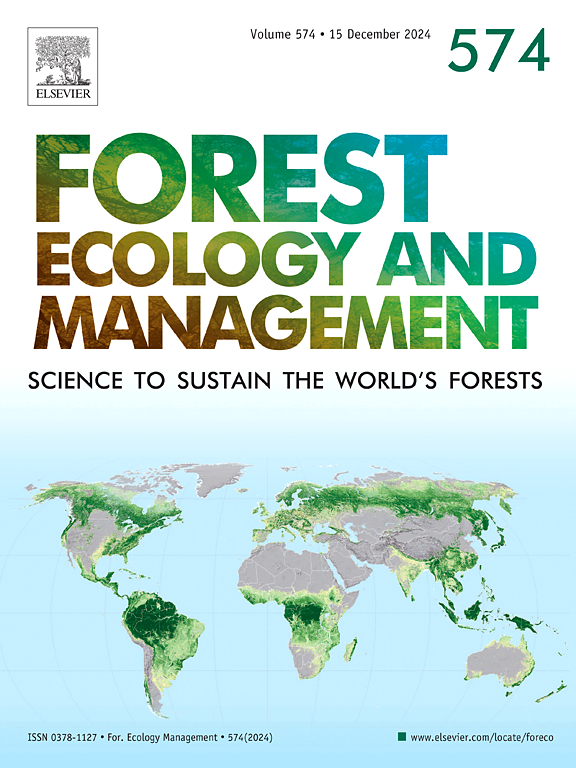森林管理后新招募幼苗群落的 Beta 多样性和物种更替
IF 3.7
2区 农林科学
Q1 FORESTRY
引用次数: 0
摘要
与生长期较长的森林相比,次生林的原生多样性往往较少。森林管理可用于鼓励幼林的多样性,增强这些森林抵御各种威胁(包括虫害和病原体)以及气候变化的能力。了解森林管理对新建立植物群落的空间和时间变异性的影响是预测整个森林景观生物多样性模式的关键。生物多样性空间和时间方面的两个关键测量指标是贝塔多样性和物种更替率。贝塔多样性量化了物种组成在空间上的变化,而物种更替则量化了物种组成在时间上的变化。我们在美国俄亥俄州东北部的一片次生林中,监测了两种常见森林管理技术(单独进行的选择性上层疏伐和与清除非本地灌木同时进行的选择性上层疏伐,以及未管理的对照组)对新招募木质幼苗群落的组成、贝塔多样性和物种更替的影响。在研究的前两年(2020 年和 2021 年),管理影响了新引进木质幼苗的组成,但在第三年(2022 年),管理处理对群落组成没有影响。我们发现,与未进行管理或仅进行上层林木疏伐的森林相比,在上层林木疏伐与非本地灌木清除同时进行的区域,β多样性较低,这表明在这些管理区域内,群落组成在不同空间的变异性较低。在上层林木疏伐与非原生灌木清除相结合的管理地块以及未管理地块中,新招募的木质幼苗的群落组成在不同年份(2020 年至 2022 年)各不相同。有趣的是,在这三年中,仅进行上层林木疏伐管理的地块中的物种组成相对一致。从 2020 年到 2022 年,不同管理方法下的物种更替并无差异。我们的研究结果表明,管理干预措施--尤其是疏伐上层林木和清除下层非本地灌木的组合--可以显著影响新引进木本植物群落的组成和多样性。事实证明,疏伐上层林木本身对林下植被的影响很小,因此需要将清除非本地灌木作为森林管理的重要组成部分。然而,由于群落内新加入的植物更替频繁,每年的结果都会有所不同。这些成分的变化表明,管理有可能改变群落内的物种平衡,并最终推动受管理森林的生物多样性。本文章由计算机程序翻译,如有差异,请以英文原文为准。
Beta diversity and species turnover in communities of newly recruited seedlings following forest management
Second-growth forests tend to have less native diversity compared to their older-growth counterparts. Forest management can be used to encourage diversity in young forests, enhancing resilience of these forests to various threats including pests and pathogens, as well as climate change. Understanding the impacts of forest management on spatial and temporal variability in newly establishing plant communities is key to predicting resultant patterns of biodiversity across the forest landscape. Two critical measures of the spatial and temporal aspects of biodiversity are beta diversity and species turnover. Beta diversity quantifies variability in species composition across space, while species turnover quantifies temporal changes in species composition. We monitored the impacts of two common forest management techniques (selective overstory thinning done alone and selective overstory thinning done in tandem with removal of nonnative shrubs, paired with unmanaged controls) on composition, beta diversity, and species turnover in communities of newly recruited woody seedlings within a second-growth forest in Northeast Ohio, United States of America. Management impacted the composition of newly recruiting woody seedlings in the first two years of study (2020 and 2021), though there was no signal of management treatment on community composition in the third (2022). We found that beta diversity was lower in areas with overstory thinning done in tandem with nonnative shrub removal, compared to forests with no management or managed with overstory thinning alone, indicating that variability in community composition across space was lower within these managed areas. Community composition of newly recruited woody seedlings varied across years (from 2020 to 2022) in plots managed with overstory thinning paired with nonnative shrub removal, as well as unmanaged plots. Interestingly, composition across these three years was relatively consistent in plots managed with overstory thinning alone. Species turnover from 2020 to 2022 did not differ across management treatments. Our findings indicate that management interventions - particularly the combination of overstory thinning and understory removal of nonnative shrubs - can significantly influence the composition and diversity of newly recruiting woody plant communities. Overstory thinning, on its own, proved to have little impact on the forest understory, instead requiring nonnative shrub removal as a critical component of forest management. However, due to high turnover of new recruits within the community, results can be variable from year to year. These shifts in composition suggest that management has the potential to alter the balance of species within the community and may ultimately drive biodiversity in managed forests.
求助全文
通过发布文献求助,成功后即可免费获取论文全文。
去求助
来源期刊

Forest Ecology and Management
农林科学-林学
CiteScore
7.50
自引率
10.80%
发文量
665
审稿时长
39 days
期刊介绍:
Forest Ecology and Management publishes scientific articles linking forest ecology with forest management, focusing on the application of biological, ecological and social knowledge to the management and conservation of plantations and natural forests. The scope of the journal includes all forest ecosystems of the world.
A peer-review process ensures the quality and international interest of the manuscripts accepted for publication. The journal encourages communication between scientists in disparate fields who share a common interest in ecology and forest management, bridging the gap between research workers and forest managers.
We encourage submission of papers that will have the strongest interest and value to the Journal''s international readership. Some key features of papers with strong interest include:
1. Clear connections between the ecology and management of forests;
2. Novel ideas or approaches to important challenges in forest ecology and management;
3. Studies that address a population of interest beyond the scale of single research sites, Three key points in the design of forest experiments, Forest Ecology and Management 255 (2008) 2022-2023);
4. Review Articles on timely, important topics. Authors are welcome to contact one of the editors to discuss the suitability of a potential review manuscript.
The Journal encourages proposals for special issues examining important areas of forest ecology and management. Potential guest editors should contact any of the Editors to begin discussions about topics, potential papers, and other details.
 求助内容:
求助内容: 应助结果提醒方式:
应助结果提醒方式:


